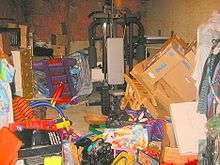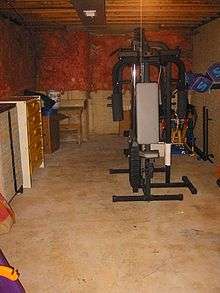Professional organizing


Professional Organizing is an industry that developed in 1984 in Los Angeles, to help individuals and businesses design organizing systems and processes to improve quality of life, personal productivity, and greater efficiency.
There are approximately 3,500 Professional Organizers and Productivity Consultants who are members of the professional association, the National Association of Productivity and Organizing Professionals[1] (NAPO).[2]
Beginning in 2002, a number of television programs aired on the subject: Life Laundry was followed by others such as, Clean Sweep, Neat, Mission: Organization, Hoarding: Buried Alive, Hoarders, Clean House, and NeatTV, as well as magazines like Real Simple.
Origins of the Professional Organizing Profession
Karen Shortridge, an entrepreneur who, in the early 1980s, began organizing residential spaces for friends and family, was featured in a local Los Angeles newspaper in 1983. The story concluded with an announcement for a meeting for "women who like to organize", taking place later in the week.
Ostensibly, the purpose of a gathering of "women who like to organize" was social in nature; more like a "kaffee klatsch" to talk about children and grandchildren, recipes, husbands, and homemaking.
But two of the women in attendance: Maxine Ordesky and Stephanie Culp, had other ideas, having no interest in discussing wet diapers. Instead, they envisioned a group devoted to business building.
At the time, both women were self-employed entrepreneurs. Maxine began her business, "The Creative Organizer" in the early 1970s. Stephanie Culp began organizing prior to 1983. Her first company, "The Grinning Idiot", an all-purpose errand company [with the tag line, "nothing is too moronic or mundane"] brought her into contact with her first organizing client.
Asking for a change to the meeting format – the room quickly divided. Those who wanted to keep it social, stayed behind in the boardroom at the bank. Maxine, Stephanie, and Ann Gambrell, a retired registered nurse, had been teaching classes on organizing homes and offices for an adult education program, and wrote an organizing column for the Daily Breeze newspaper in Torrance, California.[3]
A few short weeks later – Ann, Maxine, and Stephanie, were joined by Beverly Clower and Jeanne Schorr – for a meeting in Beverly's living room. As the group coalesced structurally and organizationally, and as the women began marketing their services for paid work, it became clear that "to the outside world, organizers were glorified housekeepers or maids." Stephanie Culp made a compelling argument to add the word, "Professional" to the women's work as Organizers – "a description that seemed outlandish at first, but which eventually overcame the ‘housekeeper’ perception and opened the starting gate to actually attracting clients."[4]
The women agreed to the new terminology, and the "Association of Professional Organizers" [APO] was formed. APO filed for 501 (c) non-profit status with the intention of "women helping women".[5] They established policies for chapters then personally managed the launch of the first four chapters – Los Angeles, San Diego, San Francisco, and New York City.
With the founding of the New York chapter in 1985, the five women created the National Association of Professional Organizers [NAPO].[6] That year, from August to September, the intrepid pioneers formalized the Association by electing officers, formulating dues, and holding elections. As meetings became monthly, the group expanded from living rooms to conference rooms, and a movement began.
Maxine Ordesky, founding President, presided over APO, then NAPO, through the first five years. She recalls, "We met in a small conference room located off a corridor in a local mall in West Los Angeles.[7] At that first meeting, I stood up in front of 10 women, not realizing, in my wildest dreams, that the organizing profession would grow to thousands of members worldwide."[8]
The first NAPO Conference was held in one of the break-out rooms in Los Angeles at the Universal Sheraton Hotel. "A seemingly impossible idea", as Stephanie Culp reminds us.[9] Ann Gambrell recalled, "We didn’t have a mailing list but we needed to fill seats. We didn’t want to be embarrassed with a low turnout so we invited our friends and husbands to help fill the room".[10]
Beverly Clower described those early years as important to her own professional development, "All these women had found their special niche, and we were all like sisters in this together. Women need to be heard and here we were: our clients and our colleagues were listening to us because we had something valuable to say".[11]
Golden Circle, the first Code of Ethics, and 501(c)(3) status, just to name a few of the many ideas, programs, and policies that originated with the Founders.
The Founders [as Clower, Culp, Gambrell, Ordesky, and Schorr are fondly referred by NAPO members] started with a notion that women could be in business using skills that many of them already possessed. They then developed that vision by building on it as a team. In a time before computers, they did everything by hand. There was no funding available, so they used their own money.
All this happened because five women had the courage and determination to take an idea that they believed in totally; they became unstoppable.
Founder Stephanie Culp is also the author of eight organizing books,[12] producing relevant content at a time when only two other books were available: Stephanie Winston's Getting Organized[13] and Don Aslett's Clutter's Last Stand.[14] Maxine Ordesky's The Complete Home Organizer was published in 1993.[15]
Watch the Founders' video, It started in LA...
Definitions
NAPO defines Professional Organizer and Productivity Consultant as follows:[16]
- A Professional Organizer supports evaluation, decision-making, and action around objects, space, and data; helping clients achieve desired outcomes regarding function, order, and clarity.
- A Productivity Consultant supports evaluation, decision-making, and action around time, energy, and resources; helping clients achieve desired outcomes regarding goals, effectiveness, and priorities.
Certifications and Credentials
Certified Professional Organizers (CPOs) have proven industry proficiency by demonstrating they possess the body of knowledge and experience essential to professional organizing and productivity consulting. The CPO® credential identifies professional organizers who’ve documented a specific number of paid hours that include transferring organizing skills to the client, and passed the Board of Certification for Professional Organizers (BCPO®) examination. The credential provides the organizing and productivity industry a way to elevate its professional standards.[17]
The National Association of Productivity and Organizing Professionals' education arm is known as NAPO University. Currently NAPO University offers two Specialist Certificates: Residential Organizing and Workplace Productivity. A third Specialist Certificate in Life Transitions will be launched in early 2018. NAPO University also offers a Business Resources Track to support Professional Organizers and Productivity Consultants in developing and growing their businesses.
Principles
Professional Organizers achieve the goal of creating and maintaining organizational systems by teaching others the basic principals of organization. Writer Julie Morgenstern suggests communicating these principals by using the acronym "SPACE", interpreted as: S=Sort, P=Purge, A=Assign a Home, C=Containerize and E=Equalize.[18] The last step ("E") consists in monitoring how the new system that has been created is working, adjusting it if needed, and maintaining it. This principle is applicable to every type of organization.
As one of their main jobs, Professional Organizers help clients reduce excessive clutter (paper, books, clothing, shoes, office supplies, home decor items, etc.) in the home or in the office.[19] Professional Organizers endeavor to help individuals and business owners take control of their surroundings, their time, their paper, and their systems for life. Professional Organizers help redirect paradigms into more useful cross-applications that ensure properly co-sustainable futures for their clients' spaces and processes.
Professional Organizers offer a wide variety of services, from designing a functional closet, to organizing a cross-country move. For homeowners, a Professional Organizer might plan and reorganize the space of a room, improve paper management, or coach in time-management, or goal-setting. In a business setting, Professional Organizers work closely with their clients to increase productivity by stream-lining paper-filing, electronic organization, and employee time-management.[20]
See also
Home:
References
- ↑ "National Association of Productivity and Organizing Professionals (NAPO)". www.napo.net. Retrieved 2018-01-22.
- ↑ "About NAPO". Retrieved 19 December 2014.
- ↑ https://www.dailybreeze.com/
- ↑ Regina Lark interview with Stephanie Culp, 21 January 2018
- ↑ Regina Lark interview with Stephanie Culp 21 January 2018
- ↑ "NAPO – How it all Began". National Association of Productivity and Organizing Professionals.
- ↑ http://www.westsidepavilion.com/
- ↑ Regina Lark interview with Maxine Ordesky 23 January 2018
- ↑ Regina Lark interview with Stephanie Culp 22 March 2015
- ↑ Regina Lark interview Ann Gambrell 15 March 2015
- ↑ Regina Lark interview Beverly Clower 5 February 2015
- ↑ https://www.amazon.com/Stephanie-Culp/e/B000APHPNA
- ↑ https://www.amazon.com/dp/B0028MVHGE/ref=dp-kindle-redirect?_encoding=UTF8&btkr=1
- ↑ https://www.amazon.com/Clutters-Last-Stand-Aslett-1995-02-01/dp/B019TLJ4KW/ref=pd_sbs_14_4?_encoding=UTF8&pd_rd_i=B019TLJ4KW&pd_rd_r=SKKNAB70RYPE07KNNZR4&pd_rd_w=5b9gf&pd_rd_wg=UYtmS&psc=1&refRID=SKKNAB70RYPE07KNNZR4
- ↑ https://www.amazon.com/Complete-Home-Organizer-Functional-Storage/dp/0802133401/ref=sr_1_1?ie=UTF8&qid=1516751763&sr=8-1&keywords=maxine+ordesky
- ↑ "About NAPO – National Association of Productivity and Organizing Professionals (NAPO)". www.napo.net. Retrieved 2018-01-22.
- ↑ "Board of Certified Professional Organizers".
- ↑ Julie Morgenstern (1 September 2004). Organizing from the Inside Out, second edition: The Foolproof System For Organizing Your Home, Your Office and Your Life. Henry Holt and Company. p. 22. ISBN 978-1-4299-5536-2.
- ↑ Buck, Claudia (February 3, 2013). "Personal Finance: It's time to tame paper tiger". The Sacramento Bee. Archived from the original on 13 May 2013. Retrieved June 3, 2013.
- ↑ "Our Profession". Retrieved 14 April 2013.